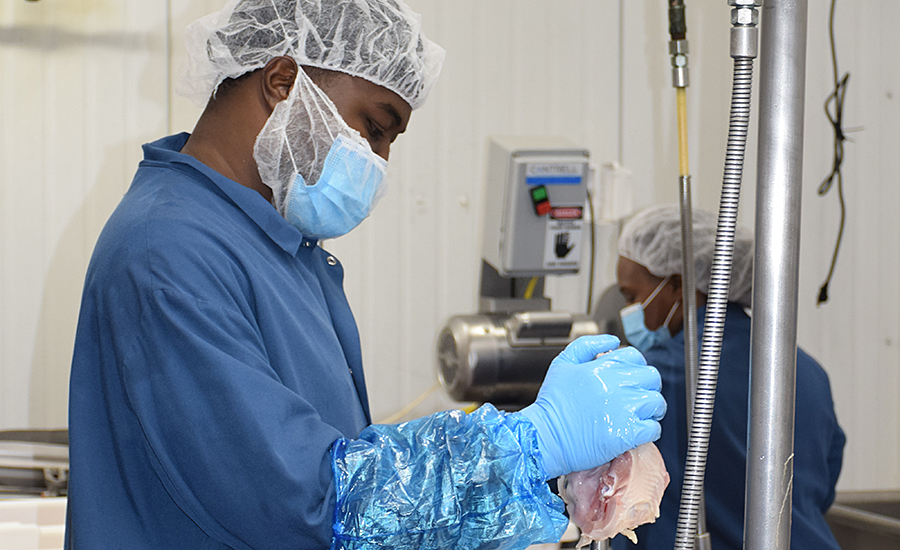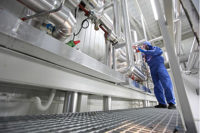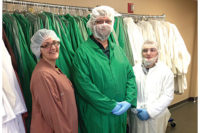In the wake of the COVID-19 pandemic, the greatest transformation to employee apparel is the adoption of masks.
“This is a respiratory agent, so distancing and containment of respiratory droplets — mask wearing — are important control measures,” says Angela Fraser, professor in the Department of Food, Nutrition and Packaging Sciences at Clemson University, in South Carolina.
Even before COVID-19, apparel could be a source of contaminants, so apparel needs to be clean and designed to prevent the introduction of hazards. “Apparel guidelines have not changed in light of coronavirus with the exception of workers wearing a mask,” Fraser says.
Ultimately, the goal for apparel worn by food handlers is to protect both the product and workers from contamination, says Nicole Keresztes-James, technical manager of food safety management at NSF International. In the meat and poultry industry, protective apparel typically includes:
- clothing that is warm enough for the conditions and fits properly with closures that will not come loose and fall off;
- clothing that does not include pockets (above the waist or below);
- garments that are built to last through multiple cleaning and sanitizing cycles, and which are subjected to ongoing surveillance;
- hairnets to cover head and facial hair, in addition to head protection (hard hats, bump caps);
- protective aprons and gloves that are single use or built to be easily cleaned and sanitized frequently;
- protective footwear, including steel-toed, non-slip soles, and covers for footwear as needed; and
- full face guards and respirators.
Fortunately, the garments that employees wear to protect against contamination of food remain fully effective, but scrutiny has been high on the effectiveness of the garments in reducing the risk of COVID-19 infection. In turn, the pandemic has increased requirements for personal protective equipment (PPE), James says. While single-use gloves were common in the meat and poultry industry for years, face masks and shields were added. Full face guards and respirators also already were employed in the meat and poultry industry, but their use is now more widespread and not restricted to employees performing certain tasks, James adds.
Pre-pandemic, advances in disposable apparel for workers and the transition away from standard cloth uniforms had been seen, as the industry recognized that single-use and non-absorbent apparel is ideal in ensuring food safety. “It is now well established that single-use apparel is ideal as well in reducing the risk of COVID-19 infection amongst workers,” James says.
Abbey Davidson, food safety consultant at We R Food Safety!, in Menomonie, Wis., says the keys to a successful employee apparel strategy during this pandemic include heightened awareness of personnel hygiene and potential contamination of product. This includes wearing long-sleeved frocks and hairnets, if not already a company policy, along with company-issued clothing rather than street clothes, including footwear, gloves and face masks.

Safer and More Comfortable
During this pandemic, Richard Stier, a consulting food scientist in Sonoma, Calif., says education and comfort are essential for a successful employee apparel program. This ensures workers properly wear what the company mandates.
“Orientations for new employees and refresher sessions for all need to emphasize personal hygiene, which includes not only what to wear and why, but why wearing the clothing provided properly is important,” Stier explains. “Their target audience is adult learners who learn and function better when educational sessions are job focused.”
The other issue is comfort.
“If the garments provided from hairnets to masks to outer garments to boots or work shoes are not comfortable, people will not use them properly,” Stier says. “So, with masks being the key during the pandemic, the company needs to look at ones that are comfortable and safe to use. If an employee wears glasses, the operation needs to look at a mask or shield that is not only comfortable, but will not fog his or her glasses, which can create a safety concern, and look closely at the elastic straps on the ears. If the straps are uncomfortable or begin to cause some pain, it is imperative that the outfit look for alternatives.”
A greater emphasis on making sure outer garments and masks are clean has occurred in light of COVID-19. “I would recommend including masks designed for multiple uses be cleaned and sanitized with the garments,” Stier says. “One should not ask employees to wash their own garments, even small ones.”
Fraser also emphases clothing needs to be laundered following CDC guidelines for treatment of textiles. “Employers should provide the clothing as some workers may not properly wash the articles of clothing, because they don’t think it is important or they don’t have laundry facilities readily available,” she says.
Pre-pandemic, the food industry was driving cost-effective and high-quality disposable apparel solutions that are manufactured in an environmentally sustainable fashion, as well as promoting innovation in the textile industry, James says. The pandemic has inspired researchers to study how apparel and viruses interact in an effort to determine which materials are least likely to hold onto contaminants. Materials such as those used to make Teflon nonstick coating, which were already making inroads into food industry apparel, are proving to be valuable in making virus-repellent fabrics. “These materials will not only prevent viruses from adhering to the apparel surface but remain effective even when the apparel is washed and reused, which is an important sustainability feature,” James says.
Masking Up
Navigating through 2021, the challenge will be to combine comfort with protection and re-use at a reasonable price.
“Masks that meet these three performance criteria at a reasonable cost will be adopted,” Stier says.
Davidson also thinks the top challenge with employee apparel is ensuring and enforcing employees wear face masks and understand why it is important, based on the science available.
“An employee who understands why they need to wear these masks, even on a basic level, is more likely to wear them, abide by the rules and keep themselves and their coworkers safer because of it,” Davidson says. “This also holds true in retail locations or with small processors who have their own marketplaces where interaction between people occurs as customers come in and out to purchase product.”
While masks have become the primary focus on personal protective equipment, companies must take care that all the other key PPE components are not forgotten. NP





Report Abusive Comment